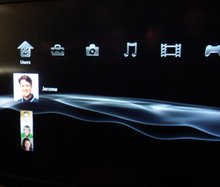The Issue: Regarding Internet video distribution, some reporters and analyst seem to be lagging behind actual marketing and engineering developments. They continue to suggest that open Internet-delivery of video to the living room TV has not yet been achieved, and is beset by insurmountable barriers.
Solutions: Current solutions do exist and mostly make use of DMAs, but these will soon be accompanied by the necessary technology integrated directly into TVs and hybrid-STBs. These solutions are open; that is, they are not tied to any particular video portal service.
Behind the scene: Active-TV technology enables TV developers to offer consumers an option to enjoy TV-web ‘browsing’. Today, anyone is free to build a TV-web formatted website or channel. TV-browsing (of TV-web channels) is freely available and as open as PC-browsing (of PC-web sites).
CNET’s Tom Krazit sees a “Fuzzy picture for Apple TV”. This comes at a time when there has been much speculation about an Apple TV ver. 2.0. The issues regarding how the Apple TV might develop next have been covered previously in this blog. The constraints remain the same, the choices include:
- Exploiting the benefits of a new and hopefully lower cost chip from Intel.
- Hiding the high-end DMA cost ‘behind-the-glass’ by integrating Apple TV into a TV.
- Morphing the Apple TV into a box that consumers already understand, such as a STB or DVD player
- Opening up Apple TV for other developers and marketers to exploit.
Ross Rubin of NPD is quoted in the CNET article saying: “the [DMA] category of devices is so nonexistent”. What he is fundamentally overlooking is that Internet delivery to the living room TV does not have to be via DMA or via closed system. Instead, it can be via a TV with integrated network support and in a manner that is completely open to all video distributors. Compounding these misperceptions is the way in which Krazit describes delivery of Internet to the living room TV as “a question that has eluded the PC industry for years”. I disagree with this: there are systems available at retail today that proof Krazit wrong (see: http://www.dlink.com/activetv/). Any failure may be in marketing the solution, not in making it technically feasible.
Responding to the CNET article, Steve O’Hear at the Last100 states “and yet it’s still difficult, if not impossible, to get content originating from most Internet TV services onto a television”. He goes on to say: “why has the AppleTV failed to ignite the market for PC to TV devices?” Two reasons are suggested: One is that Apple-TV uses PC-assistance to support its features. The second reason, which gets CNET support, is that Apple TV is a ‘closed system’, with its tight and exclusive ties to the pay-to-download iTunes Store.
Rather than being “impossible” to get Internet TV service to the living room TV, it is actually rather easy. Both Krazit and O’Hear are missing the important fact that DMAs and STB boxes are available today that support open distribution of video content. These are boxes supporting active-TV technology. Most of the Internet Video sites support an API or RSS video distribution. There is little engineering effort required to connect these to template TV-web channels. Future template developments will eliminate even these simple engineering steps. Active-TV technology is currently being integrated directly into TVs, which eliminates the little understood DMA.
Web pages formatted for the PC are not appropriate for living room viewing. This is because small text, pop-up menus and keyboard interactivity is unwanted in the living room. This does not create any great difficult for the web designer, they simply follow a new set of ‘guidelines’ which suit web pages built for the TV; Know as TV-web, interactivity is via the TV IR remote.
As Apple and others have discovered, there are overwhelming reasons why the TV is best not burdened with any direct integration of the technology required to support web 2.0. The optimal solution is networked PC assistance. After all, what web 2.0 user does not already have a networked PC?
Also missed by Krazit and O’Hear, is the ability of active-TV technology TVs to support ‘open browsing’ of TV-web formatted sites. There are a lot of interesting sites already available. Anyone is free to build a TV-web site -- there are even templates available. Moreover, active-TV technology enables all these sites to be delivered to the living room TV. Today, it is not difficult to build a TV-web version of any of the popular PC-web based Internet video sites. It is quite easy to connect their RSS feeds into available TV-web template pages.
Whatever so called “barriers” remain to Internet-delivery of video to the living room TV, they are not primarily technical, limited to exclusive content, or downright unavailable. Reporters should catch-up with this fact and better serve their readers.
Feedback, corrections and comments welcome. Contact me for more information or support with active-TV technology development.
Daniel Mann





















